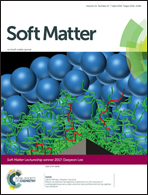Viscoelastic multistable architected materials with temperature-dependent snapping sequence†
Abstract
When an architected material with snap-through instabilities is loaded, the unit cells of the architected material snap sequentially to a series of deformed configurations. In this paper, we propose the novel concept of multimaterial viscoelastic architected materials whose snapping sequence can be tuned using temperature as a control parameter. Because different polymers have different temperature-dependent properties, it is possible that one polymer that is stiffer than another polymer at one temperature becomes softer at a higher temperature. A 3D printing inverse molding process is used to fabricate soft multimaterial architected materials that consist of two different polymers. Using finite element simulations and experiments, we demonstrate that the snapping sequence of these multimaterial architected materials depends on temperature. The influence of the geometrical parameters of the design on the critical temperature at which the snapping sequence switches from one sequence to another sequence is systematically analyzed using simulations and experiments. Being able to tune the snapping sequence using temperature makes it possible to obtain a large number of distinct stable configurations in response to compressive loads. To illustrate a potential application, we demonstrate that these materials can be used as soft reconfigurable metamaterials with tunable stiffness.



 Please wait while we load your content...
Please wait while we load your content...
